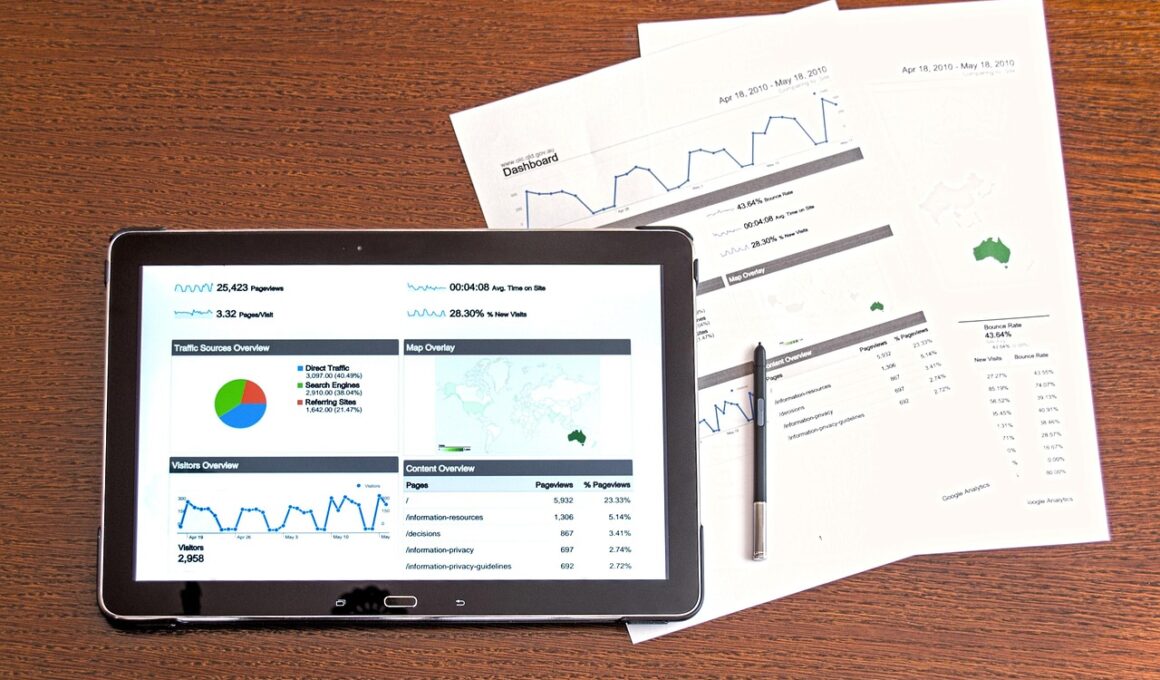Tracking Campaign Success with Analytics and KPIs
When embarking on micro-influencer marketing campaigns, it is vital to establish clear analytics and KPIs (Key Performance Indicators) to effectively measure success. The first step in this process involves defining your goals. Are you aiming to boost brand awareness, drive traffic to your website, or increase sales? Each goal should correspond with specific metrics. For instance, if your objective is to enhance brand awareness, tracking metrics like reach and impressions will be essential. On the other hand, for objectives centered around sales, conversion rates would be more relevant. It is also crucial to ensure that your goals are achievable and measurable. When your goals are clearly defined, you can better evaluate the results of your micro-influencer collaborations. Additionally, creating a roadmap for your campaign can provide direction, facilitating analysis throughout the campaign lifecycle. Utilizing analytics tools such as Google Analytics, social media insights, and proper tracking tags can significantly assist in gathering relevant data, allowing for strategic adjustments. The parameters you set now will guide future collaborations as well, enabling continued optimization and effectiveness for subsequent campaigns.
Once the goals of your micro-influencer marketing campaign are outlined, it’s essential to select the right KPIs that align with these objectives. For instance, if the primary focus is on enhancing engagement, metrics such as likes, comments, shares, and save rates should be prioritized. It’s also beneficial to analyze follower demographics and the audience’s geographic location. This can reveal valuable insights about the effectiveness of your target market engagement. If you aim for increased sales, tracking affiliate links and promo code uses will measure how many conversions stem directly from your micro-influencers’ efforts. Additionally, website traffic can be monitored, looking specifically at the source of incoming traffic. Furthermore, other KPIs like the growth in followers on your brand’s social media accounts can also reflect the campaign’s impact. Another essential component is to establish a time frame for analyzing these metrics. This period could encompass the entire campaign or be more focused on specific phases, such as the pre-launch hype and post-campaign evaluations. By doing so, you can accurately assess which tactics yield the desired results and which need more refinement.
Utilizing Analytic Tools for Enhanced Insights
To capitalize on your KPIs effectively, it is prudent to use a variety of analytic tools designed for social media metrics. Platforms like Hootsuite and Sprout Social offer comprehensive analytics solutions that can assist in tracking engagement and audience growth. These tools can help you dissect data like post-performance which can identify what resonates best with your audience. You may also consider utilizing Google Analytics to summarize the traffic driven from various influencer posts. This allows a clear view of what content typically drives users from social platforms back to your own website. Additionally, consider leveraging UTM parameters on promotional links to collect detailed information about user behavior after they engage with micro-influencers. This way, you’ll know exactly which influencer’s campaign led to conversions, thus attributing success accurately. Furthermore, the feedback and insights gathered through these tools can offer valuable recommendations for future campaigns. Comparing data across different campaigns will enable you to refine your strategies continually and focus on the most effective tactics for results. Always remember that data is powerful, but only when applied correctly can it drive substantial growth.
Analyzing what worked and what didn’t during your micro-influencer campaigns also includes evaluating the qualitative feedback received during the collaborations. Gathering insights from comments, reviews, and even DMs can provide deeper context about your audience’s perception of the brand. This qualitative data could reveal strong sentiments towards particular campaigns or associations with certain influencers. Moreover, engaging directly with your audience through surveys or polls can further enhance the understanding of their preferences and expectations. By asking specific questions related to the influencers’ messaging, aesthetic, or product recommendations, you’ll gain vital insights into your audience’s affinity toward those aspects. Additionally, conducting competitor analysis can shed light on successful strategies implemented by others in your industry. It serves as a learning opportunity to adopt best practices while avoiding common pitfalls. The goal is to evolve your collaborations through consistent feedback loops. By integrating both quantitative and qualitative assessments, you create a holistic view of campaign performance, unlocking deeper insights into driving successful micro-influencer marketing strategies.
Iterative Improvement of Campaign Strategies
Once you’ve gathered sufficient data from your campaigns, it’s crucial to employ an iterative approach for improvement. Focusing on continuous learning will enable you to fine-tune your targeting strategies and enhance overall performance. Begin by comparing your initial KPIs with the results obtained. It can be helpful to categorize outcomes into what met expectations versus those that underperformed. Delve into the underlying reasons behind successful campaigns; emulate these attributes in your future endeavors. Equally investigate which aspects fell short, asking probing questions about the content, timing, or influencer role in those instances. Importantly, understand that influencer relationships should be nurtured over time. Collaborating with the same micro-influencers can lead to stronger brand affinity and ongoing engagement, improving long-term results. Eventually, the ideal approach may involve distinguishing between top performers and learning-oriented campaigns aimed at experimentation. Embracing failure as a learning opportunity empowers you to innovate while evolving on previous campaign insights. This method ensures that your micro-influencer marketing strategy continues to grow, adapt, and respond to shifting audience dynamics.
In addition to honing your analytical approaches, it’s also essential to communicate the campaign results effectively to your team and stakeholders. Providing regular updates on analytics and insights gleaned from micro-influencer collaborations fosters transparency and encourages support. Utilize compelling visuals such as graphs and charts that illustrate the performance of key metrics to create engaging reports. Tailor these communications based on your audience; high-level summaries work for executives, while detailed analytics reports can benefit your marketing team. Incorporating storytelling elements can also enhance the appeal of your reports, helping your audience relate to the data more. Highlight success stories and case studies that showcase the positive outcomes of specific collaborations. This not only validates the effort put into the campaign but also serves as a motivating factor for future initiatives. Moreover, ensuring all members are on the same page reinforces a unified direction in your marketing strategies, optimizing both team productivity and morale. In this way, appropriate communication of results is an integral part of the overall success of micro-influencer marketing campaigns.
The Future of Micro-Influencer Analytics
As digital marketing continues to evolve, so too does the landscape of micro-influencer marketing and its analytics. Emerging tools and platforms focus on streamlining data collection and analysis, making the process more intuitive. Trends indicate a growing emphasis on automation, with AI-driven analytics becoming integral. These advancements allow brands to execute more sophisticated analyses while freeing up valuable time to strategize. Furthermore, social media platforms are increasingly incorporating enhanced insights features, leading to better user experiences and facilitating reports on campaign performance. As new metrics and indicators emerge, marketers must remain agile in their approaches. For instance, considering newer concepts such as Gen Z engagement metrics can help future campaigns connect with newly emerging audiences. Sustainability and ethics in marketing practices are also gaining momentum, prompting brands to ensure transparency in their partnerships with micro-influencers. As the marketplace changes, staying ahead of trends and technology will enable marketers to leverage data effectively, ensuring a competitive edge. Ultimately, developing robust analytic capabilities around micro-influencer partnerships will result in optimized outcomes and sustainable growth.
In conclusion, successful micro-influencer marketing hinges significantly on precise analytics and well-defined KPIs. Implementing structured frameworks for evaluation empowers brands to capitalize on insights gained from each collaboration, driving continuous improvement and engagement. Cultivating relationships with micro-influencers enables brands to harness unique voices that resonate with specific target audiences, making tracking metrics even more essential. By merging quantitative results and qualitative feedback into an actionable strategy, marketers enhance their agility and responsiveness to shifting trends. This iterative cycle will facilitate stronger relationships and greater collaboration opportunities in the long term. As brands embrace comprehensive analytics tools and maintain transparent communication, they position themselves for sustained success across all digital marketing efforts. The path forward for micro-influencer marketing is undoubtedly exciting as new methodologies emerge coupled with evolving consumer behavior. Thus, adapting analytics approaches and ensuring metric relevance will be decisive challenges for brands. Ultimately, the combination of embracing technology and fostering authentic relationships will pave the way for thriving micro-influencer campaigns that yield tangible results, making them indispensable in the digital marketing landscape.


